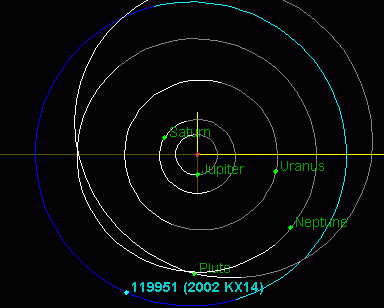(119951) 2002 KX14
| 4.862±0.038,[7] 4.6[1] | |
(119951) 2002 KX14 (
provisional designation 2002 KX14) is a medium-sized trans-Neptunian object (TNO) residing within the Kuiper belt. It was discovered on 17 May 2002 by Michael E. Brown and Chad Trujillo.[1]
It has a
semi-major axis, orbital period and orbital eccentricity close to that of a plutino.[10] The orbital periods of plutinos cluster around 247.2 years (1.5 times Neptune's orbital period), close to 2002 KX14's orbital period. However, 2002 KX14 is not a plutino, as it is not actually in a resonance with Neptune, and it may have formed near its present nearly circular orbit lying almost perfectly on the ecliptic. This TNO may have remained dynamically cold since its formation, and thus its orbit may not have been a direct result of significant perturbations from Neptune during its migration to the outer solar system. The Deep Ecliptic Survey (DES) currently classifies it as a cubewano (classical) based on a 10-million-year integration of the orbit.[2]
2002 KX14 comes to
opposition in late May at an apparent magnitude of 20.4.[8][9] This makes it about 360 times fainter than Pluto.[11]
semi-major axis of both Pluto
(pink) and (119951) 2002 KX14 (blue).See also
References
- ^ a b c d "JPL Small-Body Database Browser: 119951 (2002 KX14)". (last obs). 26 April 2006. Retrieved 7 April 2016.
- ^ Marc W. Buie (26 April 2006). "Orbit Fit and Astrometric record for 119951". SwRI (Space Science Department). Archivedfrom the original on 20 May 2011.
- 3-sigma.)
- ^ "(119951) 2002 KX14 2020 May 26". euraster.net. Euraster. 26 May 2020. Retrieved 19 September 2020.
- . EPSC2021-520. Retrieved 26 June 2022.
- ^ from the original on 10 March 2016.
- ^ a b c
Vilenius, E.; Kiss, C.; Mommert, M.; et al. (2012). ""TNOs are Cool": A survey of the trans-Neptunian region VI. Herschel/PACS observations and thermal modeling of 19 classical Kuiper belt objects". Astronomy & Astrophysics. 541: A94. S2CID 54222700.
- ^ a b "(119951) = 2002 KX14". minorplanetcenter.net. IAU Minor Planet Center. Retrieved 28 November 2022.
- ^ JPL Solar System Dynamics. Retrieved 20 July 2008.
- ISBN 978-0-12-446744-6.
- ^ (5th root of 100)^(20.4-14=363)



